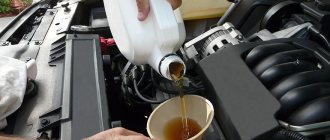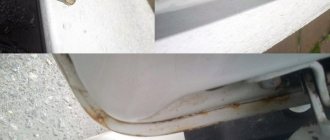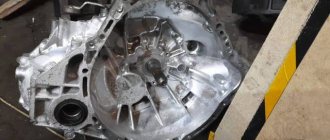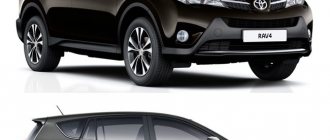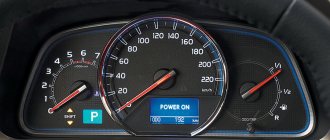Toyota Rav 4 engines 4th generation
Toyota Rav 4 4 generations
Toyota Rav 4 4 generations were equipped with the following engines :
- petrol 2.0 3ZR-FE and 2.5 2AR-FE;
- diesel engine 2.2 2AD-FHV.
2.0 3ZR-FE
A two-liter 3ZR internal combustion engine is used in the 4th generation Toyota Rav 4 in combination with a CVT or manual transmission . Main characteristics of the 2.0 Rav 4 4th generation engine:
- power (hp) – 146;
- maximum torque (N*m) – 187;
- volume (cc.cm) – 1986;
- compression ratio - 10;
- acceleration from zero to one hundred km/h (s) – 11,3;
- speed limit (km/h) – 180;
- fuel injection – distributed DOHC, dual VVT-i ;
- Timing drive – chain ;
- consumption in urban, suburban and combined cycle (l/100 km) – 9,4; 6,4; 7,5.
The approximate service life of the Rav 4 2.0 3ZR-FE engine is 250 – 300 thousand km , and the factory warranty is given for 100 thousand km or three years . Oil consumption allowed by the manufacturer is limited to 1 liter per 1000 km.
The 2.0 3ZR-FE engine has no global problems. But there are disadvantages:
- increased vibration when idling;
- quick stretching of the timing chain drive;
- difficulty starting in winter (at temperatures below -10);
- pump leaking.
For reliable operation of the 2.0 3ZR internal combustion engine, use high-quality oil and fuel and change the lubricant in a timely manner.
Engine Toyota Rav 4 2.5 2AR-FE
Toyota Rav 4 with a 2.5 2AR engine in Russia is sold only with all-wheel drive and an automatic transmission . Characteristics of Rav 4 with 2.5 2AR-FE engine:
- power – 180;
- maximum torque – 233;
- volume - 2494;
- compression ratio - 10,4;
- acceleration from zero to one hundred - 9,4;
- speed limit – 180;
- fuel injection – distributed DOHC, dual VVT-i ;
- consumption in urban, suburban and mixed cycles – 11,4; 6,8; 8,5.
According to operational data, the service life of the 2.5 AR-FE Rav 4 engine is more than 300 thousand km , and the warranty period is one hundred thousand or three years . Toyota allows the Rav 4 2.5 2AR-FE engine to consume up to 1000 grams of oil per 1000 km.
The high reliability of 2.5 2AR engines is noted, subject to timely maintenance.
The disadvantages are as follows:
- low timing chain life;
- there are leaks from the pump;
- decrease in compression level after driving more than one hundred thousand kilometers;
- When starting in cold weather, an extraneous sound appears from the VVT-i couplings.
Diesel 2.2 2AD-FHV
The 4th generation Toyota Rav 4 also uses a 2AD-FHV diesel engine in combination with a six-speed automatic transmission and all-wheel drive . Main characteristics of Rav4 2.2 diesel:
- power – 150;
- maximum torque – 340;
- volume - 2231;
- compression ratio - 15,7;
- acceleration from zero to one hundred - 10;
- speed limit – 185;
- fuel injection – direct Common-rail, DOHC ;
- average consumption – 6,7;
- timing drive – chain ;
- resource - about 300 thousand km .
2AD-FHV
The design of the 2AD-FHV internal combustion engine includes hydraulic compensators , which increase the overall level of reliability. The timing chain drive also does not cause any complaints. At the same time low fuel consumption in relation to engine power. Disadvantages:
- low particulate filter resource;
- Increased oil consumption is periodically observed;
- destruction of the cylinder head gasket is often observed;
- rapid clogging of the EGR valve.
Options and cost
The list of basic and additional equipment included:
- ABS system with ESP support in the brake drive;
- air conditioner;
- height-adjustable driver's seat;
- Cruise control;
- disc player with 6 speakers;
- electric drives of windows, mirrors and front seats.
The price and list of equipment depended on the sales market. For example, for countries with cold climates, models with heated seats were offered, and for the USA or Japan, cars with a sunroof were offered.
The standard equipment of the RAV4 included wheels with a diameter of 16″; larger wheels were offered for versions with all-wheel drive. The price of a fully equipped car on the Russian market in 2002 was 32 thousand dollars.
Motors Rav 4 3rd generation
Toyota RAV4 3rd generation (2nd restyling)
Toyota Rav 4 3rd generation was equipped with 2.0 petrol engines of two modifications : 3ZR-FE and 1AZ-FE. The crossover was also aggregated with a petrol 2.4 2AZ.
Engine Rav 4 2.0 1AZ
The two-liter Toyota Rav 4 series 1AZ-FE engine was installed from December 2008 to April 2010 . Parameters of Rav4 2.0 1AZ with four-speed automatic transmission and all-wheel drive :
- power – 152;
- maximum torque – 194;
- volume - 1998;
- compression ratio - 9,8;
- acceleration from zero to one hundred - 12;
- speed limit – 175;
- fuel injection – distributed DOHC, VVT-i ;
- gas distribution mechanism drive – chain ;
- consumption in urban, suburban and mixed cycles – 11,6; 7,4; 9,0;
- service life with good maintenance is more than 300 thousand km .
The 1AZ engine, in comparison with other internal combustion engines, is characterized by high reliability and efficiency. But provided that very good fuel and oil are used.
2.0 1AZ-FE under the hood of the Rav 4
But characteristic breakdowns also occur:
- failure of the cylinder head mounting bolts (on runs far beyond 300 thousand km);
- stretching the timing chain;
- increased oil consumption;
- problems with the direct injection system.
Engine 2.4 2AZ
Toyota Rav 4 3rd generation in the 2.4 AT Prestige Long configuration was equipped with a 2AZ-FE power unit in combination with a four-speed automatic transmission . The four-row internal combustion engine has the following characteristics:
- power – 170;
- maximum torque – 224;
- volume - 2362;
- compression ratio - 9,8;
- acceleration from zero to one hundred - 10,6;
- speed limit – 180;
- parameters – distributed DOHC, VVT-i, a timing chain is used in the timing drive ;
- consumption in urban, suburban and mixed cycles – 12,6; 7,9; 9,6.
With proper maintenance, the resource of the power unit will be more than 300 thousand km .
The manufacturer allows oil consumption up to 1 liter per 1000 km. Among the disadvantages of the ICE 2.4 2AZ are:
- failure of the cylinder head mounting bolts (at very high mileages);
- increased oil consumption;
- short timing chain life;
- susceptibility to overheating when sitting in traffic jams or driving at low speeds for a long time;
- minor but unpleasant problems - pump leakage, failure of the generator overrunning clutch, breakage of the plastic balancing clutch gears, destruction of the generator mounting pads,
The best engines of the fourth wave
The fourth wave begins in the second half of the 2000s. This is a product of the evolution of the previous generation of the ZR, GR, AR series. A distinctive feature was the appearance of the DVVT system, which is a timing drive on a chain that engages both camshafts. There is also a change in timing phases using bladed rotors. The mechanisms are installed on the gears of both camshafts.
In 2010, another modification appeared. Direct injection was introduced and a turbine was installed. These are already 6-cylinder V-shaped units. Most often found in SUVs.
Engine Rav 4 1st generation 2.0 3S-FE
The first generation Toyota Rav 4 was equipped with a 3S-FE internal combustion engine with automatic transmission 4 or manual transmission . The Toyota Rav 4 2.0 engine has the following characteristics:
- power – 128;
- maximum torque – 178;
- volume - 1998;
- compression ratio - 9,5;
- acceleration from zero to one hundred - 12,1;
- speed limit – 166;
- fuel injection – distributed ;
- timing drive - a belt that needs to be changed every 100 thousand km ;
- consumption in urban, suburban and mixed cycles – 12,6; 8,1; 9,8.
The Toyota Rav 4 2.0 3S-FE engine is easy to maintain and reliable. Among the problems, one can note an increase in oil consumption after two hundred thousand kilometers. The timing belt drive rotates the pump and oil pump.
There are no hydraulic compensators, so check valve clearances regularly.
The best engines of the second wave
The second wave of Toyota engines occurred in the late 1980s and early 2000s. This line includes classic units of the A and S series (later versions), as well as G and JZ.
The most popular is the 4A-FE, which was in use from 1988 to 2001. This version was loved by consumers the most. The model is jokingly called “folk”. The internal combustion engine is very easy to maintain and can be easily repaired. But similar installations were characterized by rapid wear of the connecting rod bearings. In addition, there were not enough floating piston pins.
From 1988 to 2005, in parallel with 4A-FE, version 5A-FE was produced. This is a basic model that was made not only in the Land of the Rising Sun. For cars in Southeast Asia, the units were made at a Chinese factory.
In 1994, a reinforced modification 7A-FE appeared. But it was released only until 2002.
Salon
The interior of the Rav 4 in the CA20 2001 body is ascetic; leather trim, available in expensive trim levels, makes the interior richer. The steering wheel is typical for 2000, the rim is thin, there are no control buttons. And the dashboard is not ordinary, there is a tachometer in the middle, but its circumference is much smaller than that of the speedometer on the left and the fuel level and coolant temperature scales on the right. Also, the non-standard dashboard background is white.
The front panel is made of plastic in two colors, dark gray on top and light gray below. The interior fabric trim is also two-tone; it can be bright to match the body color. The driver and passenger seats are simple with mechanical adjustments.
Five-door
In the second row of the five-door Rav 4 CA20 2003 body, only two passengers will be comfortable. There is no question of seating three people on the back seat in a three-door crossover.
Three-door
American car
Crossovers were supplied to the North American market only with a 5-door body. In addition to the 2-liter 148-horsepower engine, a modification was offered with a 2.4-liter engine that developed up to 160 hp. With.
The cars featured lighting technology that met American standards. The exhaust system featured improved neutralizers that made it possible to reduce the toxicity of exhaust gases to the standards in force in the United States. Many crossovers were equipped with an electric sunroof and roof racks.
Five-door crossover with a 2.4 liter engine.


